Fluppy Dogs proves they can't all be winners
Posted on Dec 16, 2019
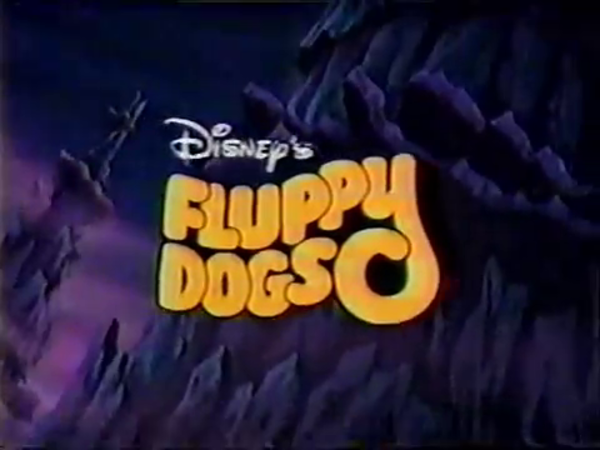
Why do some cartoon franchises fail? There are a lot of vectors a potential new marketable property can take before it inevitably dies. Most of them never get off the ground, dying an ignoble death well before they see the first light. Some franchises find their feet and get off a shaky season of television or two before being killed off. The lucky few that last may become mega-franchises and, eventually, cultural touchstones.
Fluppy Dogs is a franchise that seemed like it could make it. It had a toyline already in stores, a promising pilot, and the studio producing it was already riding off a fantastic success with Adventures of the Gummi Bears. What went wrong? Why did Fluppy Dogs flop?
Well, it failed because it wasn’t any good.
The 80s were a very bad time for cartoons. The Reagan presidency had severely deregulated standards on advertising in children’s television, causing a glut of new cartoons that were mere commercials for toy lines. Although most people who survived the 80s look back fondly on it, it’s hard to argue that shlock like Rubik, the Amazing Cube was good television.
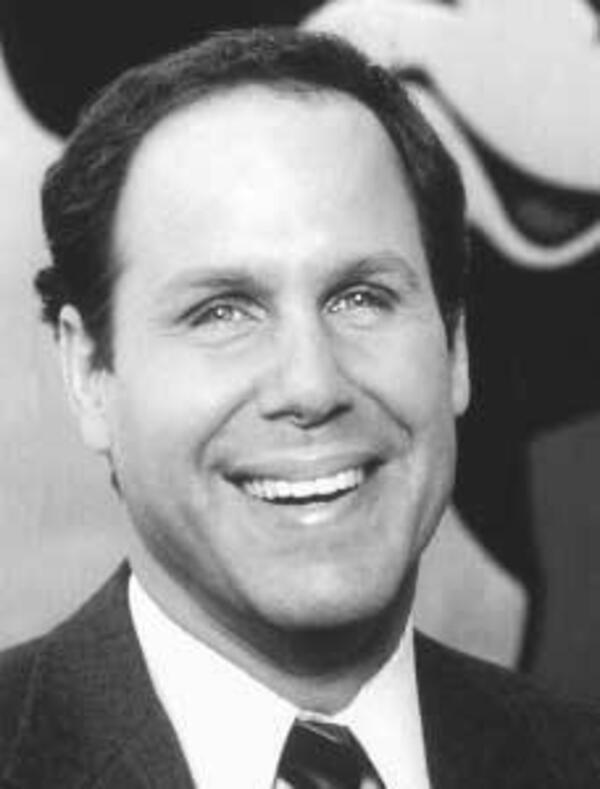
Sometimes the cure is worse than the disease.
In the 80s, Disney was having a pretty bad time itself. The company was in a rut; the Disney Renaissance was years away, the parks were struggling, and the threat of a buyout loomed on the horizon. The new CEO, Michael Eisner, made a plan: instead of focusing on massive blockbuster successes, why not work on low-budget efforts that could easily turn a small profit?
Part of this plan was to branch out into television animation, something that was considered beneath Disney for quite some time. Their first foray was Disney’s Adventures of the Gummi Bears - based directly off the popular candy, inspired by Michael Eisner’s son asking for a bag. The show featured an ensemble of colorful bears who drink a magic potion to bounce like rubber going on various adventures. Disney was apprehensive about going in on this - they considered doing television animation beneath them, and didn’t like the idea of using limited techniques to conserve budget. But Eisner pushed through, and Adventures of the Gummi Bears turned out to be a success.
Why not capitalize on that success? Another television series was an obvious path to take. Fluppy Dogs was assuredly workshopped over many laborious meetings to hit the right notes. It had to be cute, but it had to appeal to as many children as possible. It had to have the right amount of toy marketability. Gummi Bears proved that kids liked adventure shows, so it should have some degree of adventure. The formula was perfect. But, alas, the best laid plans of mice and men…
The Show
So, the general premise of Fluppy Dogs is as follows: The titular dogs are “Fluppies”, a species of walking and talking not-dogs-but-they-look-exactly-like-English-sheepdogs from another dimension. At the beginning of the pilot, our sprightly band of Fluppies have accidentally trapped themselves between dimensions, stuck seeking the interdimensional door that will return them home. They stumble into a portal that leads to Our World of modern-day America, and must continue their search for home while being hunted by a exotic animal-obsessed millionaire.
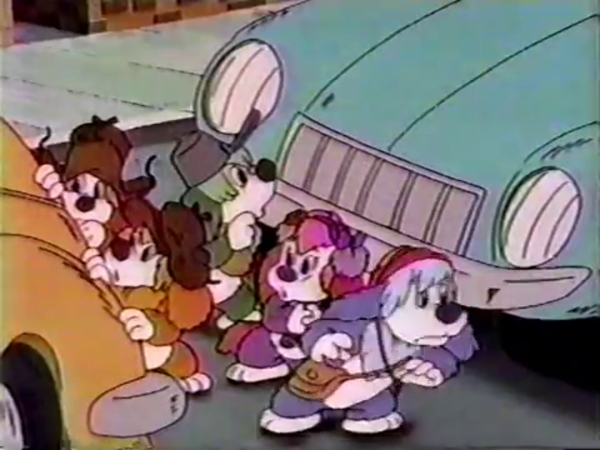
Eventually the Fluppies get mistaken for actual dogs and are sent to the local pound. A mother looking to adopt a pet for her kid picks up our Lead Fluppy and takes him home. From there, the Lead Fluppy and The Kid get into all kinds of wacky misadventures trying to free their Fluppy friends, escape the clutches of the rich man, and find a way to return home.
Doesn’t that sound like fun? It’s got it all! Marketable characters, a kid (because kids love to watch kids!), a gripping plot, cute puppies for the girls, and loads of adventure for the boys. This show couldn’t be more formulaic if you tried. Disney is not so much a company that makes art as much as it is a business of devising the most marketable properties possible.

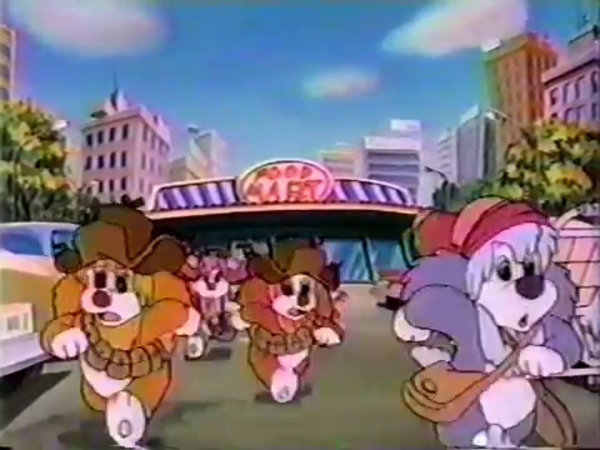
Disney’s tendency to produce properties, not art, is evident in the details of the pilot. The human characters clash terribly against the colorful dogs, and are written as one-dimensional caricatures of Popular 80s Character Archetypes. The Fluppies refuse outside help for vague reasons, when simply telling a trustworthy adult about their situation could solve the entire plot.
On the other hand, the animation quality was pretty good, and the more dramatic scenes were drawn well. Compared to most typical cartoons of the 80s, the animation is amazing! Although it was still heavily limited, the character motions were clear, expressive, and fluid. This is in comparison to shows like He-Man or most Hanna-Barbera dross that would re-use error-riddled animation wherever possible.
We don’t want to say that Fluppy Dogs was bad, really. Compared to a lot of what was going on in the 80s, it was really good! It might have showed some degree of promise as a long-form series! Wikia legends claim that a whole series bible was written by Haskell Barkin, an old hand at the TV animation biz, loaded with oddball details about where the series planned to go. New humans, new Fluppies, and a whole cocktail of new magical powers were promised. The show would be divided into three kinds of plots: the intersection of the main Fluppies and the lives of the child characters, the arrival of new Fluppies with their own problems, and travels into new dimensions for exploration.
(Note that we have no idea if anything in this supposed series bible is true. Our only source for it is a single deviantART user who wrote a few details down on the Disney wiki, claiming to have bought it off of eBay. We’re choosing to believe it’s real, because that’s more fun.)
So that was Fluppy Dogs: a totally average, completely mediocre, but pretty passable pilot that amounted to very little. Good pilots fail all the time.
The thing is, if you only knew Fluppy Dogs for its toys, you wouldn’t have known anything about what we just discussed.
The Toys
The toyline for Fluppy Dogs was nothing, not even in the slightest bit, like the cartoon. There were no elements of adventure, no human characters aside from a young girl who only appeared in a few books, and all of the characters had different names. How is this possible? It’s like a completely different franchise!
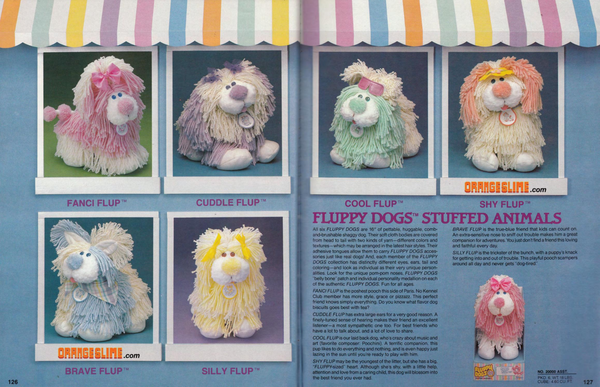
Scanned by OrangeSlime.com
Let’s get right into the meat of the matter: The toys themselves. The design of the Fluppy Dogs in the cartoon are primarily anthropomorphic, but the toys are made to look like regular dogs. They have no magic powers, cannot walk on their hind legs, but can talk. It’s never made clear if they only speak to each other in Dog Language, or if they have secret English skills that they don’t reveal to humans. There is also a lot more characters than the five we know: the Fluppy Puppies, the Puppy Twins, the Flashy Flups, a sixth main Fluppy Dog known as Fanci Flup…
Our greatest source of evidence regarding the toys comes from two primary sources: two Kenner toy catalogs scanned by Orange Slime, and a pair of read-along books scanned by Children’s Records. Just looking at these scans tells a very different story as per the trajectory of the Fluppy Dogs franchise.
Disney’s decision to have Kenner develop the toys for Fluppy Dogs reveals, what we believe, to be an unacknowledged anxiety: the growing power of American Greetings. This humble greeting card company had grown to sudden prominence in the 80s, with their Care Bears and Strawberry Shortcake becoming major hits. Which, in retrospect, is kind of weird, because they were greeting cards. But anyway, since Disney already had its own bear-themed franchise, we personally believe that Fluppy Dogs was an attempt to keep up with American Greetings’s line of adorable, girl-friendly franchises. Is this the truth? Who knows, we’re guessing.
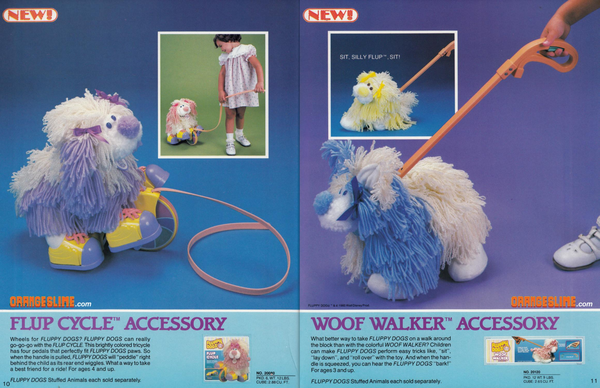
Scanned by OrangeSlime.com
But, boy, we want to get into the toys themselves. Please, take a look at that bike! Holy shit! Just strap your Flup into those bicycle shoes and drag it around! And the Woof Walker looks like you’re striking your dog with a cattle prod.
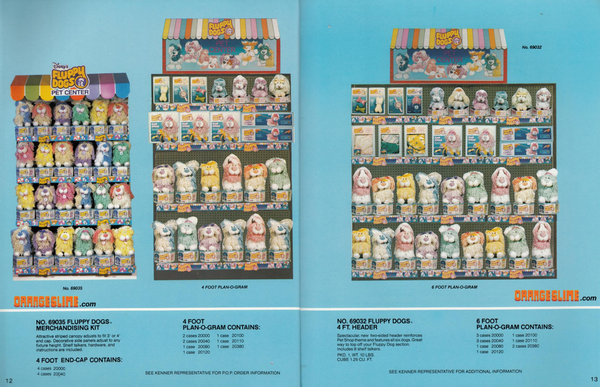
Scanned by OrangeSlime.com
While you’re here, take a look at these in-store displays for sale. Take a look at the boxes each Flup sits on - they were supposed to flip inside-out to become a basket for your Fluppy Dogs to sit inside. Does that scream adventure to you?
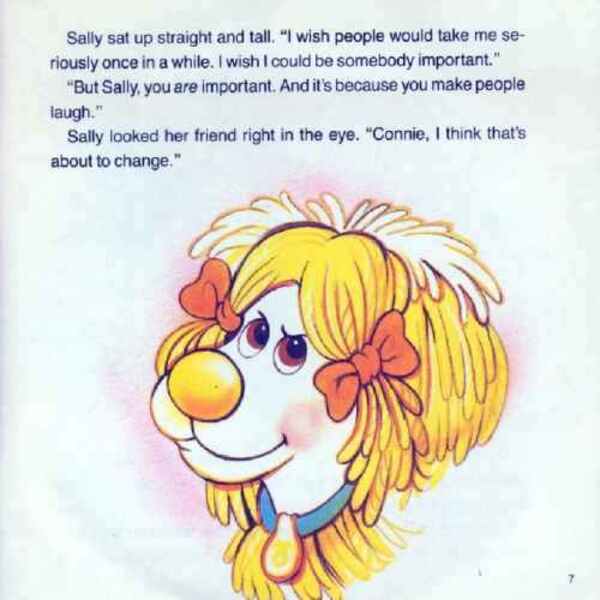
Scanned by Children's Records
As far as “adventure” goes in the toyline, the scans we have of two Fluppy Dogs books - The Happiest Fluppy and Lost and Found Fluppy - is where the bulk of the story lies. The Happiest Fluppy is focused around Sally, the Silly Flup. If you watched the show you might recognize her as Bink, where she was an inventor instead of being a “silly Flup”. Sally is tired of being the laughing stock of the gang, and tries to better herself with advice from the other Fluppies. She’s not bold enough for Baxter, the Brave Flup’s barking lessons. Cliff the Cool Flup’s sunglasses send her stumbling into fences. She doesn’t know how to work Franci the Fancy Flup’s hair curler. But when Barbara, the Fluppy Dogs’ child owner, gets injured, Sally is reminded of her true purpose: making people happy.
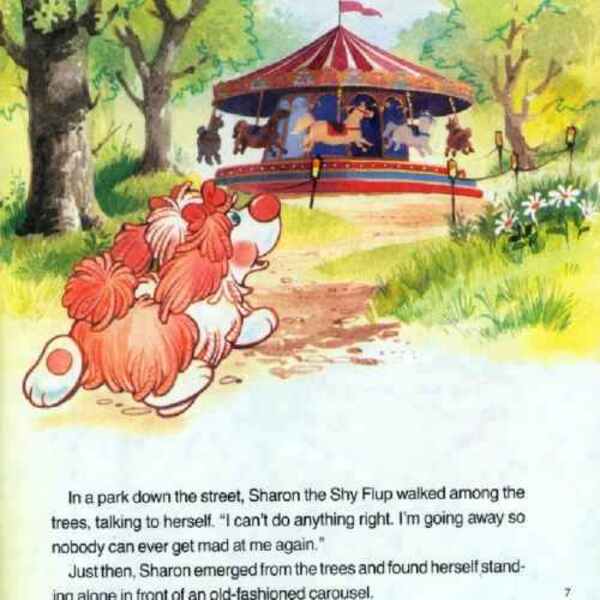
Scanned by Children's Records
The other book, Lost and Found Fluppy, is a little more adventure-oriented with Sharon the Shy Flup running away from home after accidentally offending Franci. She wanders off, stumbles across a carousel, and accidentally gets stuck on it while it is on its highest setting. The other Flups intervene, and Franci saves Sharon - at the price of ruining her perfect hair. Though adventurous, this book still is grounded firmly in reality; the only danger is the risk of being tossed off a particularly fast merry go round.
So let’s break this down. Sally, as we already established, is Bink in the cartoon. Sharon is changed to Dink, Bink’s male twin, and is totally revamped from “shy” to “precociously cantankerous”. Baxter is our main character Stanley, who retains most of his The Brave One characteristics. Cliff meanwhile is changed to Ozzie, who is a loyal if simpleminded Flup with the power to literally sniff out portals to other worlds. Connie the Cuddle Flup, who doesn’t feature very heavily in the books anyway, is revamped into Tippi, the “girl deuteragonist” of the show. Franci was written out of the show entirely! Perhaps having a fashion-obsessed Flup didn’t rate well with boys? Did she not slot into an adventure-themed series as well as the other dogs?
The only explanation we can think of for why the Fluppy Dogs toyline and cartoon were different was that the left hand didn’t know what the right hand was doing. While Disney’s toy department were cranking out dolls, books, and accessories, the TV department was struggling to find a way to make an all-appealing cartoon that would actually sell the toys. If a kid’s favorite character was the simple and friendly Ozzie, would they want a doll of the vain, hip Cliff? Would the kids who enjoyed the world-hopping sense of adventure really want to tug a stuffed animal around on a little bicycle? The concept is totally muddled. Without consistency, the target market wouldn’t understand what is being sold to them and pass over the work all together.
In Retrospect
Fluppy Dogs never reached the heights it was hoped to, but that didn’t deter Disney. DuckTales, based on Carl Barks’s line of Donald Duck comics, premiered in 1987 to immediate acclaim. This was followed by a string of cartoon premieres that are household names today: Chip ‘n’ Dale: Rescue Rangers, TaleSpin, Darkwing Duck… Notice how all of these are based off of pre-existing Disney properties? Maybe the viewing public wasn’t ready for something as new and revolutionary as Fluppy Dogs.

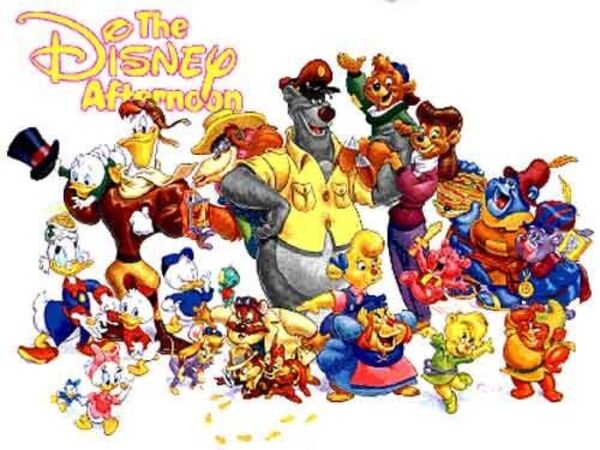
Disney found its stride in The Disney Afternoon, a syndicated programming block sold to independent broadcast stations. By the mid-90s, the image of television animation had performed a complete 180 from its nadir in the 80s. Nickelodeon has released the Nicktoons, their first lineup of original programming, making shows like Rugrats and Ren and Stimpy into instant hits. Cartoon Network premiered the first all-cartoon television channel and dipped its toes into cartoons for adults with Space Ghost Coast to Coast - an idea that would later form the incredibly successful Adult Swim.
The failure of Fluppy Dogs represents an extremely minor embarrassment for Disney. Disney had done well with its first venture into television animation (and we didn’t even touch on The Wuzzles), but its sophomore effort was a stumbling block they quickly found a way to leap over. What is most interesting about the failure of the Fluppy Dogs is that it appears to so clearly be a failure of management. If there was a better system for the toy developers and the show developers to communicate, maybe Fluppy Dogs could have been picked up for a full season… But would it have lasted past that? Let’s be real: it wasn’t that good, even if the crew were working in perfect unison. Fluppy Dogs is a reminder that they really can’t all be winners.
And, well, that’s okay. Sometimes you have to get the losers out first.
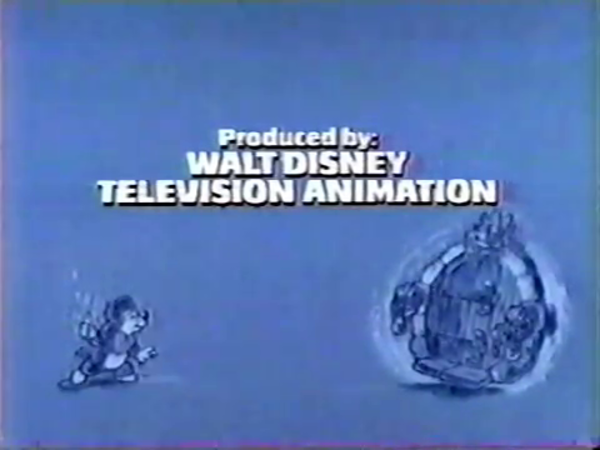
Categories: tv
Tagged: 1986 cartoon disney failed pilots fluppy dogs
On this day...
- Frail Shells (Dec 16, 2015)
- Samyang 2X Spicy Noodles (Dec 16, 2018)